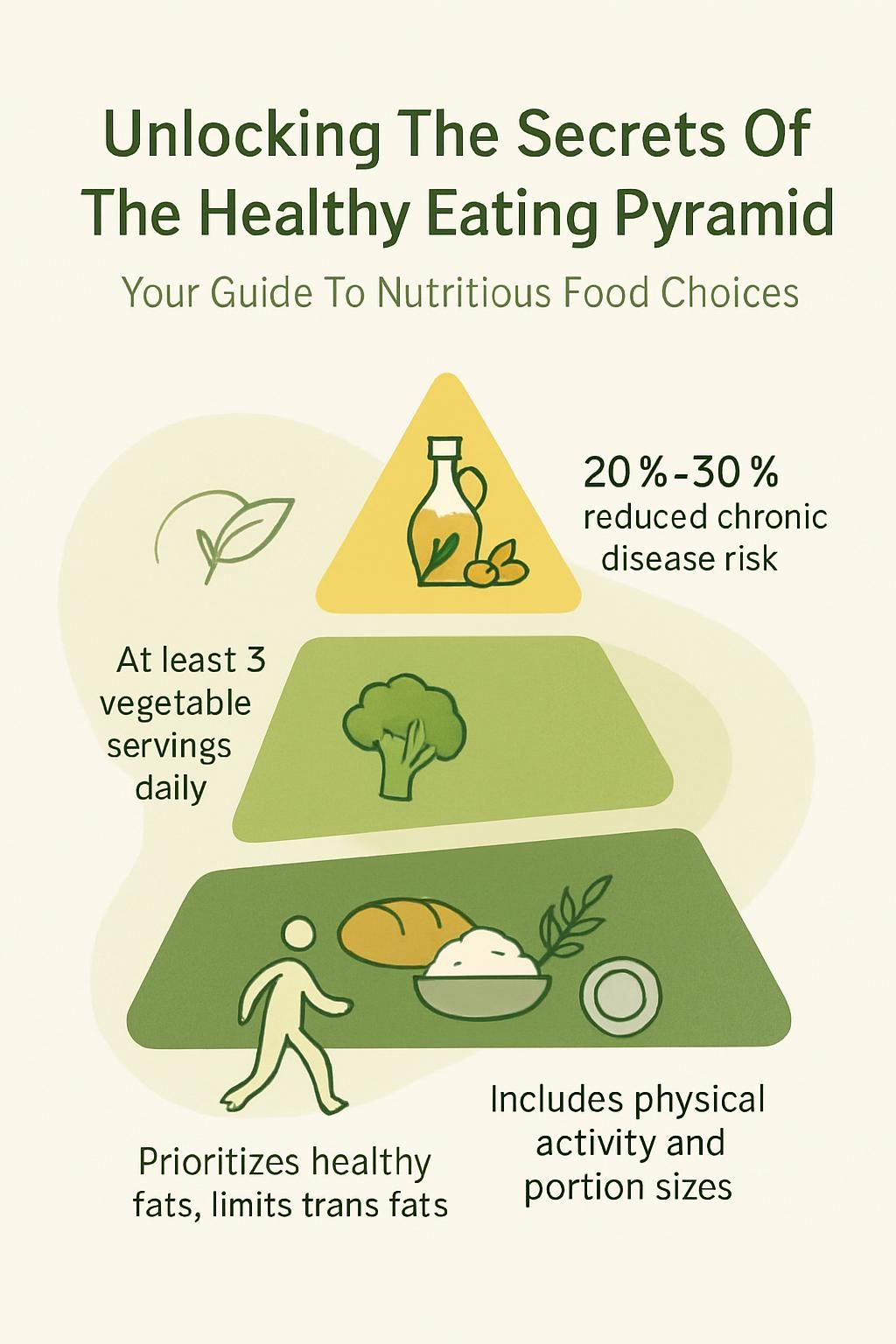Unlocking The Secrets Of The Healthy Eating Pyramid: Your Guide To Nutritious Food Choices
Our Nutrition Assistant AI Suite will transform your body. You will lose fat, get toned, and build muscle. Gain confidence and optimal health.
Nutrition advice can feel confusing. The Healthy Eating Pyramid offers a clear picture of what to put on your plate. It highlights vegetables, fruits, whole grains, healthy oils, and lean protein, which are the building blocks of a healthy eating pattern.
This guide shows how to use the Healthy Eating Pyramid to plan balanced meals and daily choices. Small steps add up, and healthy eating can be simple once you know the basics.
Key Takeaways
- The Healthy Eating Pyramid from Harvard T.H. Chan School of Public Health emphasizes plant foods, whole grains, healthy oils, and lean proteins for better health.
- Studies suggest that following the pyramid’s advice, such as limiting red meat and sugary drinks, can cut chronic disease risk by 20% to 30% (Harvard 2024).
- General guidance for adults includes at least 3 servings of vegetables, 2 servings of fruit, 3 to 8 bowls of whole grains, and 6 to 8 glasses of water daily.
- The pyramid promotes healthy fats like olive and canola oils and advises avoiding trans fat and highly processed foods high in salt or sugar.
- Compared with older USDA models, the pyramid adds guidance on physical activity and clearer portions for different ages.

What is the Healthy Eating Pyramid?

The Healthy Eating Pyramid is a visual guide that helps you choose nutritious foods each day. Experts at the Harvard T.H. Chan School of Public Health created it using current science on human nutrition.
What does the Healthy Eating Pyramid represent?
The pyramid gives a blueprint for balanced meals and daily habits. It asks you to base your diet on vegetables, fruits, whole grains like brown rice and whole wheat bread, and healthy oils such as olive or sunflower. Lean protein from fish, soy, poultry, and legumes fits in, along with modest amounts of low fat dairy.
It also calls for limited red meat and fewer processed foods, plus regular physical activity. Unlike older USDA food guide pyramids, plant foods sit at the foundation to guide your choices.
Layers make serving guidance easier to see. At the base are varied plant foods. Higher levels include proteins and dairy, with less focus on saturated fat.
Sugary drinks and highly processed snacks appear at the top as items to limit. This structure helps you meet nutrient needs while lowering disease risk through better food choices.
“The Healthy Eating Pyramid is built from scientific evidence about how different foods affect our health.”
How was the Healthy Eating Pyramid developed?
Harvard’s team designed the pyramid after concerns about the USDA’s 1992 Food Guide Pyramid. Walter Willett, a leading researcher and dietitian, led the work. They used newer research and clinical data that were not reflected in the older model.
The goal was to address rising rates of obesity, diabetes, and heart disease with a science-based approach. Australia’s Dietary Guidelines also informed the structure.
This version stresses variety, food quality, and the importance of daily activity. Harvard University owns the image and allows educational use with credit.
The Nutrition Source at Harvard provides updates, guidance, and evidence on better eating. You get a tool that favors whole grains, plant foods, healthy fats, and fewer processed items.
Structure of the Healthy Eating Pyramid
The Healthy Eating Pyramid uses layers to show which foods to eat more often and which to limit. Think of it as a road map for building a healthy diet one choice at a time.
Which foods make up the base of the pyramid?
Fruits, vegetables, and legumes form the base of the Food Pyramid (nutrition). Most adults benefit from at least 3 servings of vegetables and 2 servings of fruit daily.
Choose many kinds of vegetables and go easy on potatoes and fries, which offer fewer benefits. Aim for fruits of different colors to cover a wider range of nutrients.
Legumes, such as lentils and chickpeas, supply protein, fiber, and slow-digesting carbohydrates. These foods support weight control and steady energy. At home, my plate usually includes leafy greens, bright peppers, and black beans.
Over time, many people notice steadier energy and fewer cravings. Building meals around the base improves balance and nutrition.
What whole grains belong in the second level?
Once vegetables and fruits are on your plate, focus on whole grains next. Whole grains provide steady energy and help you feel full longer than refined grains.
Good choices include whole wheat bread, whole grain pasta, brown rice, and oatmeal. Adults often need 3 to 8 bowls per day based on age and activity. One bowl of cooked rice is about 250 to 300 milliliters, and two slices of bread weigh about 4 ounces, or 110 grams.
Choosing whole grains at most meals can lower the risk of chronic conditions such as type 2 diabetes. Less processed grains are the better bet.
Choosing whole wheat bread instead of white can make a real difference in your diet.
Which lean protein sources are included in the third level?
Fish, poultry, eggs, beans, and nuts fill the third level. Pick these lean proteins instead of red meat and cheese most days. Many experts suggest 5 to 8 taels per day of protein foods, or 200 to 320 grams total. One tael equals 40 grams.
Include 1 to 3 servings of nuts and legumes daily, about 2 ounces or 60 grams per serving. Processed meats like bacon and cold cuts raise health risks, so keep them rare.
I often swap beef for grilled fish or a serving of beans. Dinners feel lighter, and my energy holds up well. Eggs and nuts add healthy fats and iron along with protein for muscle strength.
Plant proteins such as lentils or chickpeas support a plant forward pattern and fit the healthy eating plate model.
Low fat dairy comes next, offering calcium and protein without much saturated fat.
What low-fat dairy products are part of the fourth level?
Low fat milk, low fat cheese, and low fat yogurt sit at this level. Many adults do well with 1 to 2 servings per day.
One serving equals 1 cup, or 240 milliliters, of low fat milk, 2 slices of low fat cheese, or a 150 gram container of low fat yogurt. If you avoid dairy, choose fortified alternatives or ask a clinician about calcium supplements.
These foods supply protein and calcium with fewer saturated fats. That helps you meet daily Diet (nutrition) needs while managing calories.
Keeping dairy modest supports heart health and calorie control. Next, see which oils and fats best fit the top level.
Which healthy fats and oils are found at the top?
Healthy fats and oils belong at the top. Use up to about 2 ounces, or 60 grams, daily for cooking or dressings. Favor olive, canola, soybean, corn, and sunflower oils.
These choices contain mostly monounsaturated and polyunsaturated fats, which help lower harmful cholesterol. Add small amounts of avocado, nuts like almonds or walnuts, and seeds such as flaxseed for omega 3 fatty acids that support heart health.
Avoid hydrogenated fats and products that contain trans fat. Limit butter and processed foods that are high in unhealthy fats.
With the structure in mind, the next section explains why plant foods deserve special attention.
Key Recommendations of the Healthy Eating Pyramid
The pyramid gives practical steps for daily food choices. Follow these tips to build variety and keep favorite foods in balance.
Why prioritize plant-based foods?
Plant foods such as fruits, vegetables, and legumes deliver fiber, vitamins C and E, potassium, magnesium, and helpful plant compounds called phytonutrients. Animal foods do not supply many of these in the same amounts.
People who eat more plant foods tend to have lower risks for heart disease and type 2 diabetes. Harvard’s School of Public Health notes that these foods help with weight control because they are lower in calories and high in fullness.
Eating many kinds of plants helps you get needed vitamins and minerals without relying heavily on a multivitamin. Choosing whole grain cereal and bread over refined grains also boosts fiber for better digestion.
Earlier advice once stressed quantity, like 11 servings of bread. Today the focus is on quality and variety from healthy sources. Regular nut intake is linked with better metabolic health. Pick unsalted options to keep sodium low, and use vegetable oil instead of fats from fat hydrogenation to avoid trans fat.
How to choose whole grains over refined grains?
Whole grains support the plant based foundation. Look for labels that say 100 percent whole wheat, brown rice, or whole oats. These choices supply more fiber and nutrients than white bread or white rice.
Many guides suggest that at least half of your grains be whole. A bowl of cooked brown rice, 250 to 300 milliliters, or two slices of whole wheat bread makes a solid serving. Adults can aim for one serving per meal, about 4 ounces or 110 grams.
Avoid pasta and breads made with refined flour most of the time. Switching to whole grain toast gave me longer lasting energy than white toast during busy mornings.
Small swaps improve digestion and help you feel satisfied thanks to extra fiber from healthy foods in the Healthy Eating Pyramid model.
How much sugary drinks and processed foods should be limited?
Sugary drinks add calories without helpful nutrients. Skip them when you can, and limit juice to one small glass per day. Drinks with added sugar raise the risk of chronic disease.
Processed foods such as bacon, cold cuts, sweets, white rice, white bread, refined pasta, potatoes, and red meat should be rare treats. Many contain unhealthy fats or lots of salt that can harm health over time.
Try water or sparkling water with a slice of fruit instead of soda. Use gentler cooking methods like steaming instead of deep frying to prepare vegetables and lean proteins.
Pick foods closer to those in the Mediterranean diet pyramid rather than fast food. Keep dairy to one or two servings daily, and avoid sweetened dairy drinks or desserts.
How to use healthy fats in moderation?
Better fat choices support the shifts above. Use olive or canola oil for cooking and salads. Aim for no more than about 2 ounces, or 60 grams, each day.
Replace butter based cooking with plant oils to support heart health. Add small servings of avocado, nuts, or seeds for flavor and nutrition. Avoid trans fats and limit animal fats. MyPlate guidance also favors plant based fats.
Moderate use of healthy fats can help with weight control. Simple swaps made my meals tastier and heart friendly.
Why is staying hydrated with water important?
Your body needs water for temperature control, moving nutrients, and digestion. Many adults do well with 6 to 8 glasses daily.
Water has zero calories and no added sugar. Drinking enough helps curb cravings for sweet drinks and supports a healthy weight.
Plain tea and coffee with little or no sugar can count, as can clear soups. Keep juice to one small glass because it often adds sugar without the full benefits of whole fruit.
Good hydration helps your body absorb nutrients more effectively. Switching from soda to a refillable water bottle gave me more energy for afternoon activities.
How to incorporate regular physical activity?
Movement strengthens the pyramid’s advice. Aim for at least 30 minutes of moderate activity most days. That could include brisk walking, biking, taking stairs, or a group class. Chores like gardening also count.
Regular activity supports weight control and lowers the risk of diabetes and heart disease. Harvard research shows active people cut major illness risk by about 20 to 30 percent compared with inactive peers.
I started weekend bike rides with my kids, and my energy improved within a few weeks. Exercise boosts metabolic health and complements your food choices.
Benefits of Following the Healthy Eating Pyramid
Using the pyramid gives your meals a simple, balanced structure. It helps you swap less healthy food for better options without losing flavor or enjoyment.
How does it reduce the risk of chronic diseases?
Filling your plate from the base and middle levels lowers chronic disease risk. Diets rich in fruits, vegetables, and whole grains provide antioxidants, fiber, and vitamins that protect the heart and support blood sugar control.
Evidence from Harvard T.H. Chan School of Public Health shows that replacing red and processed meats with fish and beans can cut cardiovascular risk by 20 to 30 percent. Healthy oils like olive or canola support better cholesterol levels.
Staying active and choosing water over sugary drinks add further protection, especially for type 2 diabetes.
How does it help with weight control and management?
The pyramid’s portions and food mix help manage calories. Whole grains, fruits, and vegetables are filling but lower in calories.
Switching to steaming from frying made my meals satisfying with less oil. Low fat cooking methods like boiling or steaming and limiting fats, oils, salt, and sugars can prevent excess intake.
Replacing soda with water reduces cravings. Activity remains part of the plan, helping you maintain muscle and burn extra calories.
What overall health benefits does it provide?
A balanced diet prevents nutrient gaps and supports immune function. Varied foods supply essential vitamins and minerals so you feel and function better.
Good hydration supports organs and waste removal. Healthy patterns begun early also benefit adults and older people.
Research connects nutrient rich diets with lower disease risk, better growth and development, and higher quality of life with age.
How does it serve as a simple framework for balanced eating?
The pyramid organizes grains, vegetables, fruits, lean proteins, low fat dairy, and healthy fats by how much to eat. Clear serving ideas make planning easier. For instance, you might aim for several servings of whole grains and two servings of dairy daily.
Each section lists example foods, such as quinoa for grains and almonds for healthy fats. This framework helps you plan meals and make smarter shopping lists. Harvard provides educational graphics to support learning at home and school.
The pyramid adapts to many ages and needs, giving you confidence to build balanced plates.
Adapting the Healthy Eating Pyramid for Different Age Groups
The pyramid is flexible across life stages. Adjust portions and food types to match changing nutritional needs.
What are the recommendations for children ages 2 to 5?
Young children need balance and variety. Offer 1.5 to 3 bowls of grains daily, at least 1.5 servings of vegetables, and one serving of fruit.
Provide 1.5 to 3 taels of meat, fish, eggs, or alternatives for protein needs. Include two servings of milk or suitable dairy alternatives for growth and bone health.
Keep fat, oil, salt, and sugar very low. Offer four to five glasses of fluid daily, with water as the first choice. Cooking together often sparks curiosity and builds lifelong habits.
How should children ages 6 to 11 adapt the pyramid?
School age children need steady fuel for growth and learning. Aim for 3 to 4 bowls of grains, at least 2 servings of vegetables, and at least 2 servings of fruit daily.
Provide 3 to 5 taels of meat, fish, eggs, or plant alternatives for protein. Include about 2 servings of milk or alternatives for bone strength.
Keep fats, oils, salt, and sugar as low as possible. Encourage 6 to 8 glasses of water daily. Offer whole grains and mix animal and plant proteins during the week.
What adjustments are suggested for teenagers ages 12 to 17?
Teens need more energy and nutrients during rapid growth. Aim for at least 6 bowls of grains per day. Include a minimum of 3 servings of vegetables and 2 servings of fruit.
Choose meat, fish, eggs, or alternatives totaling 4 to 6 taels for protein. Two servings of milk or fortified alternatives support bone development.
Even with higher energy needs, keep fats, oils, salt, and sugar modest. Drink 6 to 8 glasses of water daily to stay hydrated through school and activities.
How can adults follow the Healthy Eating Pyramid?
Target at least 3 servings of vegetables and 2 servings of fruit each day. Choose whole grains such as brown rice, oats, or whole wheat bread for 3 to 8 bowls daily.
Select lean proteins, aiming for 5 to 8 taels of fish, eggs, or plant alternatives. Include 1 to 2 servings of milk or fortified substitutes for calcium.
Limit fats, oils, salt, and sugar. Drink 6 to 8 glasses of water daily. Planning meals ahead and keeping a brief food log can improve awareness and consistency. Pair these steps with regular physical activity.
What adaptations suit elderly individuals?
Older adults may need extra calcium and vitamin D for bone health. Aim for 1 to 2 servings of milk or fortified alternatives daily. Soft calcium set tofu, low fat yogurt, and fortified plant milks are helpful options.
Prioritize protein from lean meats, fish, eggs, and beans to protect muscle. Aim for 5 to 6 taels each day. Choose 3 to 5 bowls of whole grains for digestion and steady energy.
Thirst can fade with age, so drink 6 to 8 glasses of water daily. Use only small amounts of fat, oil, salt, and sugar to lower the risks of heart disease and diabetes.
Fresh vegetables and fruits remain key. Try to reach at least 3 servings of vegetables and 2 servings of fruit daily to support immunity and regularity.
Comparing the Healthy Eating Pyramid to Other Food Guides
Seeing how the pyramid differs from other guides can help you pick a plan that fits your goals and culture.
How does the Healthy Eating Pyramid compare to U.S. MyPlate?
The Healthy Eating Pyramid offers more detailed guidance than U.S. MyPlate. It highlights whole grains over refined grains, healthy fats over unhealthy fats, and adds advice on hydration and activity.
MyPlate uses a simple plate graphic with food groups. It is easy to see but does not explain quality choices as clearly. MyPyramid from 2005 used color bands and required a website for details, which created access issues for some families.
The pyramid updates as nutrition science grows. MyPlate has changed less since 2011.
What are the differences with the Mediterranean Diet Pyramid?
Both pyramids place fruits, vegetables, and legumes at the base. Protein emphasis differs. The Mediterranean model favors seafood and fish, while Harvard’s pyramid includes a wider range of lean proteins such as poultry and beans.
Olive oil is the main fat in the Mediterranean plan. Harvard’s pyramid allows several healthy plant oils, including canola and soybean. The Mediterranean guide also highlights meals as social events, a feature not included in the Healthy Eating Pyramid’s tips.
Serving sizes may vary between the two. Both limit red and processed meats and sweets, though frequency can differ.
What are global perspectives on food pyramids?
Food pyramids reflect local diets and culture. In parts of Asia, rice often forms the base. Some European guides highlight bread, while Latin American guides often feature beans and corn.
Australia’s guide emphasizes plant foods and water as the main drink. Some countries include advice on hydration and physical activity, though others do not.
Portion sizes and food group focus differ by local health concerns and food availability. In Japan, smaller portions and fish are common due to tradition and need.
Many countries warn about sugary drinks and processed foods, based on public health data. While living in Australia, I noticed their simple graphics and strong push for whole grains and plant foods. Local touches help people connect with healthy eating.
Practical Tips for Using the Healthy Eating Pyramid in Daily Life
Use the pyramid as a checklist at meals and snacks. It makes balanced choices easier, especially on busy days.
How to plan meals using the pyramid?
Start with a whole grain at each meal, such as brown rice, oats, or whole wheat bread. Add at least three servings of vegetables and two servings of fruit daily for fiber and vitamins.
Include lean protein like chicken breast, beans, tofu, or fish to support muscles. For bone health, add one to two servings of low fat dairy or fortified alternatives with breakfast and lunch.
Translate pyramid servings into real portions using a simple exchange list or a note on your phone. Keep foods from the top level modest and use small amounts of healthy oils.
Drink water throughout the day. Planning with these steps helps you keep nutrition on track each week.
How to balance portion sizes effectively?
Use simple measures at meals. One serving of grains equals one bowl of cooked rice or noodles, 250 to 300 milliliters, or two slices of bread.
For vegetables, fill half of a small bowl with cooked vegetables or a full bowl with raw greens. One fruit serving could be one medium apple, two small kiwis, or half a bowl of mixed fruit.
Choose lean protein with four to five thin slices of cooked meat, one egg, or a quarter block of firm tofu per tael. For dairy, pick one cup of milk, two slices of cheese, or a 150 gram yogurt.
Pre portioned containers helped me avoid overeating on busy nights. These quick guides make it easier to meet healthy eating pyramid recommendations.
What to look for when shopping for pyramid-friendly foods?
Pick whole wheat bread, brown rice, and oatmeal for grains. Look for labels that say 100% whole grain or whole wheat. Choose whole grain pasta instead of white pasta.
Fill your cart with colorful, seasonal produce. Different colors bring different nutrients, so variety matters. Select lean meats like skinless poultry and fish, and add beans and nuts for plant protein. Skip processed meats such as bacon and sausages.
Choose low fat dairy or calcium fortified alternatives if you avoid dairy. Check labels for added sugar and trans fat, and go easy on saturated fat.
Water is the best beverage choice. Carry a refillable bottle while shopping to stay hydrated.
How to make healthy swaps in recipes?
Swap refined grains with whole grains like brown rice or whole wheat spaghetti. Use olive or canola oil instead of butter or stick margarine to cut unhealthy fats.
Replace full fat dairy with low fat milk, yogurt, or cheese. Add beans or lentils in soups and stews to reduce meat and increase fiber. Load stir fries and casseroles with extra vegetables for more volume and fewer calories.
I replaced half the meat in my chili with black beans, and the flavor stayed great while saturated fat went down. These swaps fit the healthy eating pyramid and keep meals satisfying.
Criticisms and Updates to the Healthy Eating Pyramid
Not every model fits every lifestyle. Newer updates focus on food quality, daily activity, and clearer guidance.
What are common criticisms of the pyramid?
The original Food Guide Pyramid placed too much attention on refined grains. Many people chose processed bread and pasta instead of whole grains. It also grouped all proteins together, which blurred differences between processed meats and healthier options like beans and fish.
Some critics say it minimized the value of healthy plant oils and encouraged low fat patterns that could reduce good cholesterol. The dairy section seemed high for everyone, despite lactose intolerance or different calcium needs.
MyPyramid required going online for details, which limited access. In school, some families without home internet missed important guidance, showing the need for clear print resources.
What modern updates and modifications exist?
Harvard experts updated the pyramid to reflect current research. The newer version stresses whole grains, healthy oils, plant proteins like beans and nuts, and a rainbow of fruits and vegetables.
Physical activity appears as a foundation at the base of the image. Water replaces sugary drinks as the preferred hydrator.
The Nutrition Source team shares ongoing tips so you can stay current. Weight control now has a stronger focus alongside smart food choices.
These updates make day to day guidance clearer for adults who want a healthier eating plan.
Conclusion
Daily food choices shape long term health. The Healthy Eating Pyramid gives you a practical path to better nutrition. Fill your plate with vegetables, fruits, whole grains, healthy oils, and lean proteins, then keep portions of sweets and processed foods small.
Evidence from the Harvard T.H. Chan School of Public Health links these habits with lower chronic disease risk, often by 20% to 30%. Hydration, regular activity, and simple meal planning strengthen the results.
Follow the pyramid across life stages to build lasting habits. If you have medical conditions or special dietary needs, seek advice from a healthcare professional or a registered dietitian.
Small, steady changes guided by the Healthy Eating Pyramid can help you stay healthy and enjoy food every day.
FAQs
1. What is the healthy eating pyramid and how does it guide nutritious food choices?
The healthy eating pyramid is a visual tool that ranks food groups by their nutritional value. It places whole grains, fruits, and vegetables at its base to encourage frequent consumption. Lean proteins, dairy alternatives, and healthy fats appear in moderate amounts above these staples. Foods high in sugar or saturated fat are near the top as items to eat less often. This structure helps people make balanced meal decisions based on scientific evidence from nutrition studies.
2. How can I use data from the healthy eating pyramid for daily meal planning?
You can refer to serving recommendations found within the pyramid’s guidelines for each food group. For example, adults should aim for at least five servings of fruits and vegetables per day according to research published by Harvard T.H. Chan School of Public Health (2020). A simple table listing recommended servings makes it easier to track your intake throughout the week.
3. Are there proven health benefits linked with following the healthy eating pyramid?
Yes; several long-term studies show that diets aligned with this model lower risks of heart disease, type 2 diabetes, and obesity (Willett et al., 2019). People who follow these principles tend to have better cholesterol levels and healthier body weights compared with those who do not adhere closely.
4. Can personal experience help me stick with nutritious choices suggested by the pyramid?
Applying lessons from real life supports lasting change in diet habits. For instance, after switching my breakfast routine from pastries to oatmeal topped with berries and nuts—a choice inspired by the base layers of the pyramid—I noticed improved energy during mornings at work over several weeks.
Summary: The healthy eating pyramid organizes foods into clear categories based on nutritional science; using its guidance leads many people toward healthier meals each day while supporting long-term well-being through practical application and evidence-based advice.







